October 15, 2010
Air Date: October 15, 2010
FULL SHOW
SEGMENTS
California’s Climate Law on the Ballot
View the page for this story
This November, California voters will decide whether or not to rollback the state’s plan to reduce climate change emissions. Terry Tamminen is the former secretary of the state’s Environmental Protection Agency and the founder of Seventh Generation Advisors. He tells host Bruce Gellerman what’s at stake both economically and environmentally in next month’s election. (05:50)
Gulf of Mexico Half a Year Later
/ Jeff YoungView the page for this story
Six months after the BP blowout began, LOE’s Jeff Young asks scientists what we know so far about the oil’s effects. For some species the direct toll from the oil is less severe than many had feared. But the long-term impacts could mean the worst is yet to come. (06:00)
The High Price for Free Wind Power
/ Bruce GellermanView the page for this story
After a ten-year battle through government bureaucracies, courts, and regulatory agencies, the nation's first offshore wind farm has just one more hurdle: money. Host Bruce Gellerman reports on how Massachusetts is trying to find a way to finance the Cape Wind project, even if it means relying on taxpayers. (13:00)
Science Note – Surfing Crocodiles
/ Meghan MinerView the page for this story
Australian scientists track the world’s largest reptiles. As Meghan Miner reports, saltwater crocodiles really know how to catch a wave. (02:00)
Finally an Affordable Electric Car
/ Ingrid LobetView the page for this story
Nissan has just come out with a 100% electric car that they call the Leaf. LOE’s Western Editor Ingrid Lobet took it out for a spin and tells host Bruce Gellerman about the test drive. (04:30)
Coming Clean About Household Cleaners
View the page for this story
Cleaning companies are notoriously secretive about the chemical contents of their products. But now, New York is reviving a 1976 law that requires manufacturers to disclose chemical ingredients in household cleaners. Urvashi Rangan, an environmental health scientist and Director of Technical Policy at Consumer’s Union, discusses the disclosure with host Bruce Gellerman. (06:45)
BirdNote®- Northern Shovelers Pinwheeling
/ Frank CorradoView the page for this story
What goes around, comes around is how Northern Shovelers move about when they’re skimming the water for food. The behavior of these fine feathered ducks is described by Frank Corrado in our BirdNote®. (02:00)
Wearing Local
/ Lonny ShavelsonView the page for this story
Rebecca Burgess has set up a challenge for herself: for one year, she will dress in clothes made in fibers that are grown – and made – within 150 miles from her California home. Burgess created The Fibershed Project to point out that commercially-made clothing has an enormous carbon footprint and to show that fashion can be both attractive and sustainable. Lonny Shavelson reports. (06:45)
This week's EarthEar selection
listen /
download
California Sea Lions barking, honking, and wheezing in Monterey Bay.
Show Credits and Funders
Show Transcript
HOST: Bruce Gellerman
GUESTS: Terry Tamminen, Melanie Driscoll, David Godfrey, Doug Inkley, Urvashi Rangan, Katherine Jolda, Connie Ulasewicz, Rebecca Burgess
REPORTERS: Jeff Young, Bruce Gellerman, Ingrid Lobet, Lonny Shavelson
NOTE: Meghan Miner
BIRD NOTE: Frand Corrado
[THEME]
GELLERMAN: From Public Radio International, this is Living on Earth. I’m Bruce Gellerman. Building a green energy future – our best hopes could be blowing in the wind offshore.
GORDON: We are the Saudi Arabia of offshore wind.
GELERMAN: And it’s free as the wind…but critics say there’s a price to pay.
HAUGHTON: The problem with offshore wind – wind power that’s built out at sea – is just the enormously high cost of building the windmills in the first place.
GELLERMAN: Despite the government go-ahead the nation’s first offshore wind farm could be gone with the wind. Also, six months later – scientists take stock of the damage from the BP oil disaster and efforts to save wildlife.
GODFREY: It did work. And it was the right thing to do at the time. We needed to do something to save those hatchlings. A very well orchestrated plan was put in place and we got it right.
GELERMAN: These stories and more, this week on Living on Earth. Stay with us!
[THEME]
California’s Climate Law on the Ballot
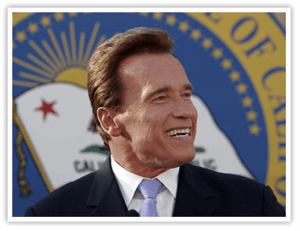
Terry Tamminen was Governor Schwarzenegger’s secretary of the California Environmental Protection Agency. (Photo: Terry Tamminen)
GELLERMAN: From the Jennifer and Ted Stanley Studios in Somerville, Massachusetts, this is Living on Earth. I’m Bruce Gellerman. California has the seventh largest economy in the world. So four years ago, when the state adopted an ambitious plan to reduce greenhouse gas emissions, the world took notice. Now that plan, officially known as Assembly Bill 32, could be history even before it’s implemented. Opponents say the bill will stall California’s already stale economy and have placed Proposition 23 on the ballot this November. Prop. 23 would roll back AB 32. Terry Tamminen was Governor Arnold Schwartzenegger’s secretary of Environmental Protection when AB 32 passed. Today, he’s head of Seventh Generation Advisers, a climate change consulting firm. Mr. Tamminen, welcome to Living on Earth.
TAMMINEN: Thanks for inviting me.
GELLERMAN: So, for those of us not familiar with California’s climate laws, what exactly is Assembly Bill 32?
TAMMINEN: AB 32, as it’s called, also known as the global warming solutions act- a pretty lofty title- was designed and passed in 2006 to help California do our fair share to reduce greenhouse gas emissions, modernize the economy with clean energy and energy efficiency and low carbon economic development.
GELLERMAN: So now comes Proposition 23, it’s the ballot initiative, which is up to voters in California this November. And, it would basically, as I understand it, not kill Assembly Bill 32, but roll it back. Is that right?
TAMMINEN: That’s right. I mean it effectively does kill it because it says that it could not be implemented until unemployment reaches very low levels. And that just puts a lot of uncertainty into the process, which currently is on a path to quite a bit of certainty.
GELLERMAN: Supporters of Prop. 23, which would roll back 32, have a very well financed campaign.
TAMMINEN: There’s no question that the proponents of Prop. 23 are well financed. And, in some ways it’s being financed by you and me, because we know that it’s mostly from three major oil companies from out of state- one Oklahoma, two from Texas- that have bankrolled this with millions and millions of dollars. And I say that money comes from you and me because every time we fill up our cars we are supporting the oil industry that is effectively turned back the clock a hundred years on technology and California’s economic future.
GELLERMAN: So would there be international implications if Californians voted to roll back AB 32?
TAMMINEN: You know, California has a history of being a leader on environmental policy, whether it was being the first to have a clean air act, or a clean water act. The U.S. Congress then typically follows, and then often the rest of the world does. And, although Europe was ahead of us on climate change policy, China, which is the other big emitter along with the U.S. that so far has no major regulations, is kind of waiting. And, if the U.S. doesn’t act and realize that the rest of the world is not going to come up with a comprehensive solution to this problem- so if California can’t do it, this great leader on environmental technology and policy, if California can’t do it, you can imagine that Congress would pretty much stall any action and therefore the U.S. is not going to be part of the solution.
GELLERMAN: So as goes California, so goes the United States?

California’s Republican Governor, Arnold Schwarzenegger has been a supporter of the state’s climate bill. (California Office of the Governor)
TAMMINEN: Exactly. And, therefore, unfortunately, so goes the world. You know, California has acted like a nation state, especially under Governor Schwarzenegger, and has reached out and signed agreements with provinces in China, with states in Brazil to deal with deforestation, with countries in Europe, with provinces up in Canada and so on, because we realize that there’s a real need to share policies, to share technologies, to figure out how to do these things together. And it’s something the world understands, and is still struggling with. So, California could still certainly still honor those commitments, but really what’s harmed is those economic developments that is likely to be coming with them.
GELLERMAN: That economic development would be done by companies. How would Proposition 23 affect the investment in clean technologies?
TAMMINEN: Well, if Prop. 23 passes, and effectively ends the implementation of AB 32, then the price on carbon doesn’t occur, there isn’t a market place for carbon emissions where creative businesses can figure out how to reduce faster than others and then trade credits to one another. The whole concept of a cap and trade is to bring down emissions but allow business the most creative and cost effective ways to achieve it.
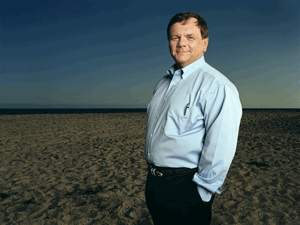
Terry Tamminen was Governor Schwarzenegger’s secretary of the California Environmental Protection Agency. (Photo: Terry Tamminen)
And so, for example, the deal that California struck with Brazil to allow carbon credits to be created that could be traded into California and Western states market place for well managed forests that have proved they’ve reduced greenhouse gas emissions by forestry practices- those credits could be traded to a company in California that has an obligation to reduce that hasn’t been able to do so yet- they could buy those credits from Brazil. That entire marketplace goes away and that entire economic driver for economic development on both ends of the equations- goes away.
GELLERMAN: If Proposition 23 were to pass, would California still be able to move forward on some clean energy fronts?
TAMMINEN: Well, certainly, I mean California has been a leader in solar before the passage of AB 32, we passed our own million solar roofs initiative under Governor Schwarzenegger, for example. And, we have our renewable portfolio standard, which is helping utilities to make California much greener in terms of the electricity that they deliver to customers. We have our tailpipe emissions standards from clean cars; those standards were adopted by the Obama administration as national standards.
So, there’s a variety of measures in place, that with our without AB 32 would move forward, but, again, it creates a time of uncertainty which businesses would always come to me when I was in government and say, ‘The one thing we want is certainty. We can deal with a little more cost or you know, some other way of doing business- we just want certainty so we can plan.’ And, Prop. 23 is entirely going in the wrong direction.
GELLERMAN: Terry Tamminen is founder of Seventh Generation Advisors, his latest and soon to be released book is “Cracking the Carbon Code.” Mr. Tamminen, thank you very much.
TAMMINEN: My pleasure, thanks for asking.
Related links:
- Click Here for More Information on AB 32
- Click Here for More Information on Prop 23
- Seventh Generation Advisors
Gulf of Mexico Half a Year Later
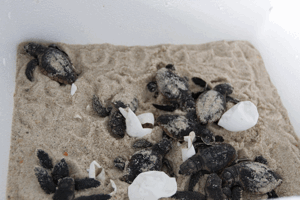
Hatchlings emerge from their shells. (Sea Turtle Conservancy)
GELLERMAN: October the 20th marks half a year since the BP oil disaster. The explosion killed eleven workers and before the well was capped some 200 million gallons of oil had gushed into the Gulf of Mexico. Within days the Obama administration imposed a moratorium on deepwater drilling in the Gulf; this past week the feds lifted the ban and imposed much stricter safety rules and regulations on the oil industry.
But much more murky is the state of the Gulf ecosystem. During the disaster we spoke with many wildlife scientists. Now, six months later, Living on Earth’s Jeff Young caught up with some of them to find out how the Gulf is doing.
YOUNG: It was in mid-May when I last spoke with Melanie Driscoll of the Audubon Society’s Louisiana Coastal Initiative. Driscoll walked the beach of Louisiana’s Grand Isle, counting birds and looking for signs of the massive oil slick. She knew then that the ultimate effects would be hard to spot.
DRISCOLL: There’s a saying about ecology that ‘it’s not rocket science, it’s a lot more complicated than that.’

Audubon’s Melanie Driscoll on Grand Isle, La. The oil’s direct impacts were less than she’d feared, but she warns long term effects could still take a toll on some of the nation’s most important bird habitats. (Photo: Jeff Young)
YOUNG: (Laughs.)
DRISCOLL: We’re looking at a system. The birds rely not just on their feathers insulating them, they rely on food chains that are underwater or in the sand. They rely on protection from predators by being familiar with their surroundings, it’s very complicated.
YOUNG: Federal records show that some 95 species of birds were collected from the Gulf coast during the oil blowout. Nearly 7,000 died. And oddly, that’s the good news. Driscoll says she had feared a much higher body count by now.
DRISCOLL: And, what we know now is that the direct effects are much less than they might have been. Fewer birds were oiled and therefore, less death initially. We’re still very concerned, though, about the longer term effects of oil in the food chain, oil in the environment, and that we may not be seeing the effects on their reproduction or their survival for a number of years.
YOUNG: Now, Driscoll is watching the fall migrants. They need the delta’s bounty of insects, worms, and crustaceans to fuel up for the flight south. Driscoll fears that oiled islands and wetlands might still be tainted or simply not offer enough food. So wildlife officials are trying to lure birds away from shore by flooding inland fields, creating new habitat. But, Driscoll says, many species are still drawn to the coast, where they always go. She’s finding the most birds in the spots with the most remnant oil.
DRISCOLL: That’s what we saw at the six month mark was, because these areas are traditionally such good areas for birds, the birds are choosing to be there, even though those are the areas that have the most oil. So we have concerns that they may be having to work harder to fatten up, or they may not fatten up as well- and therefore not be as fit to fly across the Gulf.
YOUNG: Other scientists I spoke with share Driscoll’s mix of relief about the oil’s direct impact and uncertainty about the long-term. Back in early July, groups that work with endangered sea turtles were looking at a dire situation. Turtles were coming ashore to nest just as the oil hit. Sea Turtle Conservancy Director David Godfrey, told us about a daring plan to move the turtle nests.

Hatchlings emerge from their shells. (Sea Turtle Conservancy)
GODFREY: Well, in essence what we are trying to do is save this year’s entire hatchling class of sea turtles from the north Gulf coast of Florida from emerging from their nests and then swimming out into the Gulf to really meet almost certain doom.
YOUNG: Federal and state officials, non-profit groups and volunteers hand-dug some 25,000 eggs and loaded them into special containers. Fed Ex trucks carried them across the Florida peninsula to the oil free waters of the Atlantic. It was unprecedented. And risky. We called Godfrey back to see if it worked.
GODFREY: It did work and it was the right thing to do at the time. The oil conditions were such that we needed to do something to save those hatchlings. A very well orchestrated plan was put in place and we got it right.
YOUNG: About 15,000 hatchlings got a fresh start in the Atlantic. As for the turtles in the Gulf, some 600 dead have been collected. Whether the turtles can bounce back depends largely on how their habitat recovers from the oil.

The first sea turtle hatchlings are released. (Sea Turtle Conservancy)
[BOAT SOUNDS]
YOUNG: In late July, I took a boat trip near the mouth of the Mississippi with National Wildlife Federation Conservation scientist Doug Inkley. Inkley was looking for the floating brown algae, called sargassum. It’s crucial habitat for sea turtle hatchlings, fish larvae and other small creatures.
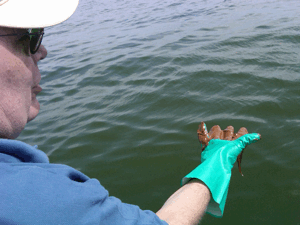
National Wildlife Federation’s Doug Inkley found oil in the sargassum weed in July. By August fresh sargassum had floated in, greatly improving habitat for baby turtles and fish larvae. (Photo: Jeff Young)
INKLEY: You can see how it’s got a lot of surface area for eggs and larvae to hang on to.
YOUNG: A glob of oil on your hand there.
INKLEY: Oh yeah there is oil coming right out of the sargassum. Every place that we’ve seen sargassum so far we’re seeing the oil in blobs. So everything that’s attracted to sargassum here, is, in essence, being attracted to oil.
YOUNG: Then, rusty brown blobs lurked under the surface as far down as we could see. But, just a little more than a month later. The Sea Turtle Conservancy’s Godfrey found much better conditions.
GODFREY: You know, it was kind of surprising to be honest with you how normal it looked. Healthy mats of sargassum weed had floated in from other areas from the Gulf where they have never been exposed to oil. That sargassum was full of all the sorts of critters- fish, crabs, even found a lot of healthy juvenile turtles in that habitat.
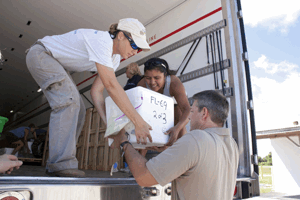
David Godfrey unloads turtle eggs on the Atlantic coast. (Sea Turtle Conservancy)
YOUNG: The surface looks good, Godfrey says, but most of the remaining oil is in the depths, where the effects are harder to measure. Scientists I spoke with say it’s far too early to know what’s happening to deep-sea creatures or animals like the sperm whale, and the bluefin tuna. The government has just started it’s full accounting of the spill’s full impact with what’s called the Natural Resources Damage Assessment, NRDA, as it’s known, can take years. And most researchers compiling that official report can’t talk about their work. All of which means most answers about what happened at the Deepwater Horizon disaster, are still on the distant horizon. For Living
on Earth, I’m Jeff Young.
Related links:
- Audubon report birds 6 months after the spill started
- NOAA maps of animal strandings
- FWS reports on bird impacts
- Sea Turtle Conservancy on turtles and the spill
- Some of LOE’s stories on the spill’s impacts: Sea Turtle relocation
- Birds and the coast
- Sperm Whales in the Gulf
[MUSIC: Trombone Shorty “Quiet As kept” from Backatown (Verve 2010).]
GELLERMAN: Just ahead - even a weatherman can’t tell which way the wind is blowing for the nation’s first offshore wind farm. Keep listening to Living on Earth!
[CUTAWAY MUSIC: Pat Metheny: “Orchestrion” from Orchestrion (Nonesuch Records 2010).]
The High Price for Free Wind Power
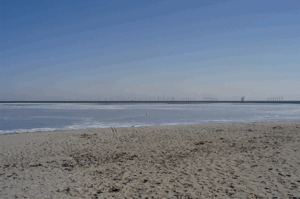
An artist’s rendition of what Nantucket sound will look like with offshore windmills. (Cape Wind)
GELLERMAN: It’s Living on Earth, I’m Bruce Gellerman. Offshore wind is the fastest growing source of electricity in the world but the United States has been slow to harness the power of wind at sea. While Europe has 40 offshore wind farms operating today and 20 more in the works…the U.S. has precisely zero.
But that could rapidly change now that Google has announced it’s getting into offshore wind power--or I should say Google is getting under offshore wind power. The company has announced it’s teaming up with a New York financial firm to fund the construction of a huge underwater transmission line. The grid would connect still to be built wind farms at sea off the mid-Atlantic coast. Here’s Google’s Rick Needham.
NEEDHAM: This will serve as a superhighway with on ramps for wind farms and the ability to intelligently be expanded to increase the amount of offshore wind that’s available.
GELLERMAN: The U.S. is blessed with some of the best offshore wind in the world. By government estimates, the wind off the Atlantic Coast, Gulf of Mexico and Great Lakes could potentially generate four times the amount of electricity than that currently produced by all of our existing power plants combined.
GORDON: We are the Saudi Arabia of offshore wind.
GELLERMAN: And, Jim Gordon has big plans to make use of that embarrassment of renewable riches. Gordon is president of Cape Wind, a Massachusetts company planning to construct the nation’s first offshore wind farm. If and when it’s built, it will produce enough electricity to power to nearly a quarter of a million homes, with no climate change emissions.
GORDON: Cape wind is the largest single greenhouse gas mitigation initiative in the United States.
[SOUND OF WATER AND WIND]

An artist’s rendition of what Nantucket sound will look like with offshore windmills. (Cape Wind)
GELLERMAN: On Nantucket Sound just off the coast of Cape Cod, the wind blows strong and steady. It’s here on a 24 square mile site, on what’s called Horseshoe Shoal, that Jim Gordon wants to erect Cape Wind: 130 huge turbines mounted on giant towers driven deep into the shallow seafloor and close to transmission lines on land.
Cape Wind spokesman Mark Rodgers calls the site the perfect place to create energy out of thin air.
RODGERS: You know the basic concept is quite simple and I think that goes to kind of the elegance of it, which is that instead of burning coal or natural gas to create heat to boil water to make steam to exert a force to turn a turbine, right- which is how electricity is made the conventional way- or in the case of a nuclear reaction to create heat do the same thing, you know, here it is just the source of wind turning the wind turbine blades.
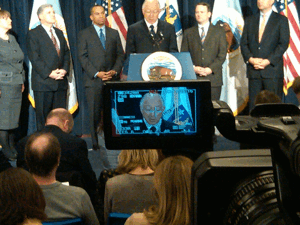
US Secretary of the Interior, Ken Salazar speaks to the press about Cape Wind (Photo: Jeff Young)
GELLERMAN: Offshore wind produces no air pollution, or radioactive waste. There’s no possibility of an oil disaster or the threat of foreign embargos. The wind is inexhaustible and the cost for the fuel- the wind- is zero. But…there’s a but…
HAUGHTON: It’s easy to get dazzled by the notion that wind has to be cheap… you know, the wind is free.
GELLERMAN: Jonathan Haughton is senior economist at Beacon Hill Institute. Over the years the free-market, think-tank has produced a series of reports that conclude Cape Wind will hurt tourism, and lower property values, now Haughton says the project is just too expensive.
HAUGHTON: The problem with offshore wind, wind power that’s built out at sea is just the enormously high cost of building the windmills in the first place. It’s the capital costs that’s the killer compared to onshore wind. If it had to operate on a market basis it simply wouldn’t start.
GELLERMAN: Ten years ago when it was first proposed Cape Wind was projected to cost 750 million dollars…today the construction costs have more than tripled. Cape Wind has been treading water for nearly a decade because never before had anyone tried to build a wind farm off the U.S. coast.
Jim Gordon essentially had to invent the process. It meant navigating 17 federal bureaucracies and state agencies…negotiating 140 laws and statues, producing a bookshelf of new environmental studies and surveys …and successfully fending off a dozen lawsuits.
GORDON: It shouldn’t take this long…because while we’ve gone thru this ten year tortuous process, the Europeans and now even the Chinese are blowing past us in terms of the off shore wind industry.
GELLERMAN: Still, despite the fact that Cape Wind has received all the federal and state permits and environmental permissions it needs, the project continues to be a hot political issue.
[APPLAUSE SOUNDS FROM GUBINATORIAL DEBATE]
GELLERMAN: At, the first gubernatorial debate in Massachusetts, Cape Wind was the issue.
PATRICK: It’s amazing that only in Massachusetts can we say that a project that has taken ten years to get from concept to final approval is hasty.
GELLERMAN: Democrat Governor Deval Patrick is running for reelection and the only candidate supporting Cape Wind.
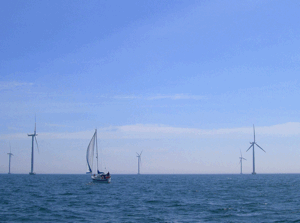
An artist’s rendition of a sailboat among the proposed Cape Wind windmills. (Cape Wind)
PATRICK: I think it is good for us from an environmental point of view, from an energy point of view, from an economic point of view, and from a symbolic point of view.
GELLERMAN: Independent Candidate Tim Cahill disagrees.
CAHILL: Cape Wind is the wrong project, in the wrong place at the wrong time. We’re talking about windmills. Windmills is not a new technology. It’s not a technology that really, I think is moving us forward. It would be like me saying we should go back to steam engine rather than diesel for freight trains.
GELLERMAN: Republican candidate Charlie Baker says he supports renewable energy…just not Cape Wind.
BAKER: There are other alternatives that are available to us that are cheaper, more affordable, and in the end I believe better from a diversification strategy than this one. This is a monstrous big bet on one project when in many ways we probably should be better off letting a thousand flowers of other kinds bloom along the way.
GELLERMAN: Perhaps surprisingly, Jill Stein, the Green-Rainbow Party candidate, also questions the value of the offshore wind project.
STEIN: As Cape Wind comes to us it today it clearly is not delivering the most green energy for every dollar invested. And it’s asking for an enormous investment, probably two and a half billion dollars, that will mostly come from ratepayers.
GELLERMAN: A recent Boston Globe poll found nearly 70 percent of Massachusetts residents favor Cape Wind, but support drops to half when the price of its energy is considered. It’s only now, at the end of the process, that consumers have learned the price they’ll pay. Matt Da Prato, is an offshore wind analyst with Emerging Energy Research.
DA PRATO: Yeah it was one of those bridges that people didn’t really think about until they had to cross it and now we’re at that point and it’s at the forefront. And it’s a decision that ratepayers and policy makers will have to make on is this cost reasonable and are we willing to bear this burden.
GELLERMAN: “Reasonable” is the critically important word Massachusetts law uses to set renewable energy rates. But what’s reasonable to pay for energy from the nation’s first offshore wind farm? To find an answer, I headed to a hearing at the Massachusetts Department of Public Utilities.
My route turned out to be a small metaphor for the twists and turns the Cape Wind project has taken over the past decade.
[STREET NOISE]
GELERMAN: The DPU is located in Boston’s South Station. First, I got a badge from the receptionist…
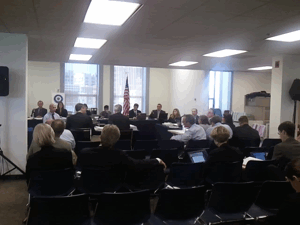
At the end of the labyrinth leading to the Massachusetts Department of Public Utilities you’ll find lawyers and industry lobbyists determining if the price of Cape Wind’s energy is reasonable. (Bruce Gellerman)
[ELEVATOR DINGS]
GELLERMAN: And took an elevator to the second floor…
[ELEVATOR DINGS AGAIN]
GELLERMAN: There I showed my badge to another receptionist who gave me a key. I unlocked a door, held it open with my foot, and tossed the key back to the receptionist. Then at the end of a long hallway overlooking the train station, I walked down a short flight of steps…
[SOUND OF WALKING UP STEPS]
GELLERMAN: Then, took another elevator up to the fourth floor…
[ELEVATOR DINGS]
GELERMAN: And followed handwritten signs.
[SOUNDS OF THE HEARING ROOM]
GELLERMAN: The labyrinth led to a makeshift hearing room, which I found filled with lawyers and industry officials.
[WOMAN IN THE HEARING: In addition there are a number of information requests that have submitted pursuant to motions for protective treatment…A-G dash C-W dash three dash seven …A, B, and C….]
GELLERMAN: They were listening to a mind-numbing litany of renewal energy regulation minutia.
[WOMAN IN THE HEARING: A-P-N-S dash AG dash 1 dash…]
GELLERMAN: This slow moving hearing might lack the high drama of political debate, but it’s here that the future of Cape Wind, and indirectly, that of the nation’s offshore wind industry will be decided. Investors will be looking to see if offshore wind can be profitable.
For Cape Wind, it means convincing two of the three public utility commissioners that the cost of energy from the wind farm is “reasonable” and worth the price consumers will pay. But even Cape Wind’s Mark Rodgers acknowledges the price is high.
RODGERS: Well, offshore wind is more expensive than land based wind for example.
GELLERMAN: More than twice as expensive as wind generated on land or electricity produced by burning fossil fuels or nuclear power. Offshore wind requires special barges and costly equipment during construction and the towers and turbines have to be built to weather corrosive seawater and violent storms.
Initially Cape Wind wanted 21 cents a kilowatt-hour for its electricity. The Massachusetts Attorney General was able to knock two cents off that rate but permitted the price to rise three and a half percent a year for inflation. And utilities that purchase the electricity will get another four percent a year just for doing the deal. That’s too steep a price says Washington attorney Glenn Benson.
BENSON: Yeah, what they want to do is have Massachusetts’ ratepayers pay for the cost of developing Cape Wind when there are lower priced competitive alternatives available.
GELLERMAN: Benson represents Cape Wind’s nemesis, The Alliance to Protect Nantucket Sound. Fossil fuel billionaire Bill Koch is co-chair of the alliance and one of its largest financial backers. The Alliance’s new target is Massachusetts biggest utility, National Grid, because National Grid has agreed to buy half the energy Cape Wind will generate for 15 years.
BENSON: What we believe in is competition. And national grid should be buying from the lowest priced alternative, unless they show a really compelling reason to do otherwise and I don’t think they’ve come close to that here.
GELLERMAN: Actually, National Grid has a compelling reason: it’s required by law. Massachusetts, and 30 other states, have renewable energy portfolio standards. Each year utilities must purchase an increasing percentage of their energy from renewable sources. For Massachusetts it’s 20 percent renewable by 2020 and it goes up from there. And the state goes even further. Utilities must lock-in to long-term, clean energy contracts.
Ronald Gerwatowski, general counsel of National Grid, did a supply and demand analysis of the company’s future energy needs and found the utility had no alternative but to buy energy from Cape Wind.
GERWATOWSKI: And when we look across the next ten or 15 years, and we see this huge renewable resources gap and it’s our judgment that gap can’t be filled without Cape Wind being part of the mix.
GELLERMAN: Because utilities get their electricity from a variety of sources National Grid calculates the high price of Cape Wind energy will only cost the average consumer about a dollar and a quarter more a month. And Ian Bowles, Massachusetts Secretary of Energy and Environment, says the long-term contract will act as a hedge against fossil fuels price hikes in the future.
BOWLES: My view is that the contract is more likely than not to save money for consumers over its 15-year life. You know only thing we can say about energy price forecasting is that it’s almost always wrong and almost always too low.
GELLERMAN: Just two years ago, before the economic recession, energy demand and electricity prices were 30 percent higher. Back then the average Massachusetts ratepayer’s bill was 20 dollars more a month than today.
Supporters of offshore wind say its a long-term investment in the future that the added cost today is a small price to pay not just for clean, renewable electricity, but for launching a new industry that could add tens of thousands of jobs. The U.S. Department of Energy predicts by the year 2030 we’ll need a hundred Cape Wind sized projects, but the choice is ultimately ours says Matt Da Prato analyst with Emerging Energy Research.
DA PRATO: You know people aren’t going to put down their Ipods anytime soon. They’re not going to turn off their HDTV so it’s a matter of what price are you willing to keep that and that’s both an economic price and an environmental price. And the degree to which ratepayers and taxpayers think that we have to be more mindful of our environment will be the degree to which renewable energy succeeds or fails in the United States.
GELLERMAN: Massachusetts Department of Public Utilities will decide if the cost of Cape Wind’s energy is reasonable by mid November. But opponents still intent on killing the project have filed four new lawsuits and litigation could scare off potential investors. In the coming weeks, I’ll have a report about generating jobs and competition among states as they try to catch the wind.
Related links:
- Cape Wind
- Save Our Sound
- National Renewable Energy Laboratory
- Emerging Energy Research
[MUSIC: The Ventures “Perfidia” from Revenge Of The Surf Instrumentals (MCA Records 1995).]
GELLERMAN: Coming up – turning over a new leaf - an electric leaf, that is. But first this note on Emerging Science from Meghan Miner.
[MUSIC: : The Ventures “Perfidia” from Revenge Of The Surf Instrumentals (MCA Records 1995).]
Science Note – Surfing Crocodiles
MINER: Surfers aren’t alone in their love of riding waves. Ocean-dwelling crocodiles like to catch big water swells, too.
[SCIENCE NOTE THEME]
MINER: Saltwater crocodiles are the world’s largest reptiles. They can be as long as 20 feet and weigh as much as 3,000 pounds! These massive beasts spend most of their time lounging in waters throughout the coastal Pacific, and have surprisingly little genetic diversity for such a large range.
Scientists have long wondered how these relatively poor swimmers travel to distant places. So Australian researchers in Queensland decided to monitor the creatures.
They tagged 27 saltwater crocs and tracked their positions for a year using sonar transmitters and underwater receivers.
And what they discovered is that these reptiles are not unlike their human counterparts when it comes to surfing the waves! The crocodiles use surface ocean currents and wait for the best conditions before catching a ride out to sea. And they have a good sense of direction- an earlier study found that these crocs were able to find their way back home after being relocated hundreds of miles away.
For years, mariners have reported spotting seeing these floating giants far from land, but now sightings can be validated. And, with all four claws paddling along in the water, these bulky behemoths really know how to “hang 20!”
That’s this week’s Note on Emerging Science. I’m Meghan Miner.
Related link:
Read More About Surfing Crocodiles
Finally an Affordable Electric Car

The Nissan Leaf has a small cargo space, but rear seats fold down separately for, allowing room for 3 people plus larger packages.
GELLERMAN: A London Times reporter recently set a world efficiency record, driving a standard VW Passat from Kent, England to the South of France and back – 1530 miles - on just 20 and a half gallons of gas. That’s 75 miles per gallon.
But Nissan’s new car, the Leaf, gets five times better mileage with no gas at all. LEAF has become a bacronym- Leading, Environmentally, Friendly, Affordable, family car - and Living on Earth’s forward-looking Western Bureau Chief Ingrid Lobet took it for a spin. Ingrid, how was it?
LOBET: It wasn’t really that different from driving other cars in its class, maybe a Nissan Centra, Toyota Corrolla, Honda Civic… except that handling was maybe a little bit better. Really responsive—nothing sloppy in the handling of this car at all. And the other thing is, of course since it’s electric, you have really strong pick up, because you’ve got the full torque of the motor as soon as you touch the accelerator. And, also I was impressed with how tightly it took the curves.
GELLERMAN: And quiet, I guess, right?
LOBET: Silent. Yeah, electric cars are quiet.
GELLERMAN: Is it big, is it small, is it comfortable?
LOBET: It’s comfortable. I have to tell you it really reminds you of driving another car that would be in the same size class, like a compact car. So, you don’t have a feeling of luxury, but you don’t really feel cramped. You definitely can put five people in this car and they say you can put three car seats across the back- if you had the need for three car seats at one time, Bruce.
GELLERMAN: (Laughs.)
LOBET: You can also fold those rear seats down and you can fold them down in two different units. So you could have, let’s say, a second passenger in the back, but put a larger piece of luggage in the back by folding down the other half of the back seat- so it’s got that kind of flexibility that a lot of the compact cars already have.

The Nissan Leaf is priced at $32,500. Subtract from that a federal $7,500 tax credit. Some states also have rebates. In California, the rebate is an additional $5,000, bringing the price down to close to $20,0000. The car is currently sold out on the west coast.
GELLERMAN: How far can you go?
LOBET: About 100 miles. But this will depend somewhat on the weather. Because, if you need to turn on the heat, or the AC, if you have to run that very much, then you’re going to get less. You’re going to get maybe only 65 miles to the charge. But if you have mild weather, you don’t need to run the AC or the heat, and you’re going maybe 40 miles per hour most of the time, you might get more, like 135 miles to the charge.
GELLERMAN: Now, we should say that this is not a hybrid, there’s no two motors- there’s one motor and it’s an electric motor.
LOBET: This is a fully electric, battery only car: no gasoline.
GELLERMAN: But what if I take it for a drive and I run out of juice- what do I do? Where do I go?
LOBET: Well, see, this is clearly the limitation of an electric car, and it’s why the nay-sayers say it will really never be much of a market for an electric car because you can’t take this on a long drive if you have a long commute to work each day, this is not the car for you. And, it’s also not the car you’re going to want to take on the long trip to Grandma’s house either, because you’re going to have to recharge after 100 miles.
GELLERMAN: So, Ingrid, how long does it take to juice this car up? To charge it up?
LOBET: If you buy one of these cars, I think you’re probably going to want to go to the extra expense of hiring an electrician to bring the same voltage into your charging space- your driveway or your garage- that you have for your dryer or your electric stove. The regular outlet voltage, 110, is probably going to take too long, so charging it at 240 volts it’s going to take about five hours, or overnight.
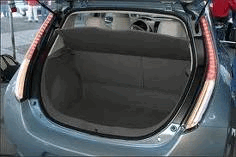
The Nissan Leaf has a small cargo space, but rear seats fold down separately for, allowing room for 3 people plus larger packages.
GELLERMAN: At what price? What’s the cost?
LOBET: 32,500 dollars. Subtract from that the federal tax credit of 7,500 dollars, that brings the price down to 25,000 dollars, and a number of states have their own rebates, California gives you a 5,000 dollar rebate, that brings the price down to 20,000 dollars plus tax.
GELLERMAN: Whoa! That’s really incredible!
LOBET: It’s an affordable electric car.
GELLERMAN: So, what was the reception towards this when you took it out for a test drive? People were kind of bending their necks to take a look?
LOBET: Yeah, the place was jammed, and besides that, you can’t even sign up for one of these things. The first 20,000 vehicles that they had available are already spoken for, so you can’t even put money down right now. So, this is really a pleasant surprise for Nissan, and I have to say it vindicates the electric vehicle enthusiasts, who’ve said for years, that despite the limited range, there is a demand for a fully electric vehicle.
GELLERMAN: Well Ingrid, happy motoring.
LOBET: Thanks a lot Bruce. It’s been a pleasure!
GELLERMAN: Ingrid Lobet is L-O-E’s Western Bureau chief.
Related link:
Nissan Leaf
[MUSIC: Minimal Compact “Autumn Leaves” from There’s Always Now (remixes and remakes) (Crammed Disc 2004).]
GELLERMAN: Coming up--shrinking the carbon foot print of your clothes - just ahead on Living on Earth.
[CUTAWAY MUSIC: Booker T & The MG’s “A Woman, A Lover, A Friend” from Green Onions (Atlantic Records 1962).]
Coming Clean About Household Cleaners

Living on Earth's Hona Liles checking out some cleaners in the LOE kitchen.
GELLERMAN: It’s Living on Earth, I’m Bruce Gellerman. Do you have any idea what’s in the cleaning products underneath your kitchen sink? We didn’t. So we asked L-O-E’s Honah Liles to take a look under ours.
[SOUND OF BAGS RUSTLING]
LILES: Let’s see, we have Uni San Kitchen heavy duty all surface cleaner. The label on the can says, ‘non-flammable, no phosphates, harmless to the environment’…And there is a list of contents: sodium bicarbonate, nonylphenol ethoxylate, triethanolamine…
[BAGS RUSTLING]
LILES: Let’s see, what else? Sun Sations with OXYgen cleaning action…‘Caution: keep out of reach of children, avoid irritating fumes, do not mix with chlorine bleach.’ But I don’t see the ingredients anywhere.
[CABINET DOOR SHUTTING]

Living on Earth's Hona Liles checking out some cleaners in the LOE kitchen.
GELLERMAN: These days, finding out the chemicals in household cleaners is hit or miss. But 35 years ago, the New York legislature decided it was time for manufacturers of cleaning products to come clean and reveal their ingredients. The law was never enforced though – that is, until now. The New York Department of Environmental Conservation is dusting off that long forgotten law and holding hearings on how to implement it. Urvashi Rangan is an environmental scientist and Director of Technical Policy for Consumer’s Union. Thanks for joining us.
RANGAN: Oh you’re so welcome; it’s a pleasure to be here.
GELLERMAN: So how is it that a 35 year-old law requiring disclosure of chemicals in products has never been enforced?
RANGAN: Yeah, it’s not really clear how it was never enforced. A group called Earth Justice, which is an environmental law firm actually came upon the statute and filed suit against four large cleaning manufacturers, to force them to disclose the ingredients on their formulations. They did not win that lawsuit, but they began efforts to encourage the Department of Environmental Conservation in New York to enforce the law in and of themselves.
GELLERMAN: So what are the benefits of disclosure? I mean, why disclose?
RANGAN: Most consumers think what they pull off the supermarket shelves is safe, or has been demonstrated as being safe. They would be surprised to learn that a number of the ingredients that are used in cleaning products today may not be as safe as they think. Beyond that, consumers want to be able to purchase the safest products on the market. And, without full ingredient disclosure, they simply can’t make informed or comparative choices.
GELLERMAN: What about federal laws? Aren’t there federal laws requiring disclosure of chemicals in compounds?
RANGAN: There are some federal laws regarding incredibly hazardous materials used in cleaning products. If you have a hazardous material, or the product itself is hazardous, you have to use certain types of labels. If you have an antibacterial cleaner, or a disinfectant, it’s actually a pesticidal product, and the active ingredients in these pesticidal products, have to be disclosed.
GELLERMAN: I know a lot of companies are now moving to voluntary disclosure, and they’re doing it online…
RANGAN: There are a number of progressive companies who are really going above and beyond what’s required of them today to provide ingredient disclosure. They can even do a better job too, when we look at things like plant-derived surfactant as an ingredient. Tell us what surfactant it is.
GELLERMAN: Well, I’m going to go to a website. It’s ‘what’s inside SC Johnson dot com.’
[TYPING]
GELLERMAN: I’m looking at their Fantastik with pure orange oil. Let’s see it’s got a chelator, it’s tetrasodium EDTA. Fragrance information will be added soon. And, dye… it’s a brilliant orange dye, it’s called…but that’s it!
RANGAN: Yeah, and we’d like to know what’s inside the ‘brilliant orange dye’ and we’d like to know what’s inside the fragrance. These companies know that people want this information, and the steps they’ve taken are very positive, but they haven’t gone quite far enough. And, this is ultimately where we would like to see full disclosure of these ingredients.
GELLERMAN: Yeah, if I press on the tetrasodium EDTA, all it says is a chelator that removes soils. Doesn’t help me much.
RANGAN: No, and one of the parts of this law in New York that’s very interesting is that these ingredients should be disclosed along with their health or environmental hazard information. And, that’s something that consumers are also looking for in terms of being able to make the best-informed choices.
GELLERMAN: More and more products are making a virtue out of using the quote, unquote, natural ingredients. I’m trying to find out what “natural” means, and, according to federal law, it’s kind of meaningless.
RANGAN: Yeah, unfortunately, the natural label is almost one of the top green-washing terms for us. There are very few standards behind what that term means. It only necessarily might mean that something came from a natural source. But, you can extract something from a plant and you can also chemically react that into an ingredient. And so, that term is very loosey goosey, and consumers shouldn’t rely on that term without doing some additional homework. Non-toxic is another one of those labels that just has no standards behind it and no verification what so ever.
And, in fact, in a report we did on cleaners and reported that non-toxic had no standardized meaning, we heard back from a company who sent us a lot of documentation to support their use of non-toxic. In review of that documentation, we actually came upon a carcinogen that’s used in the product, and so, it’s just sort of highlights how companies can use that term really any which way they want to, even if they have a little bit of carcinogen in their product to.
GELLERMAN: Urvashi, are you one of those consumers who I see standing in the market isle reading the fine print?
RANGAN: Well, for my job here at Consumer Reports, I am that consumer standing in the store reading the labels trying to make sense of them, yes.
GELLERMAN: What about when you go shopping? Do you know what to buy?
RANGAN: Not all the time! And I see new labels all the time on the market and I always have to ask myself- what do they mean, is somebody behind them? Is there a set of standards behind it? And, when it comes to cleaning products, when I see labels, I can’t often find ingredient decks that are specific enough for me to be able to make a proper judgment, and that’s the kind of thing that we’d like to see get better, for, not only the consumers but to level the playing field in the marketplace.
GELLERMAN: Urvashi Rangan is an environmental health scientist, Director of Technical Policy for Consumer’s Union, and the project director of Consumer Reports’ greenerchoices dot org. Urvashi Rangan, thank you very much.
RANGAN: You’re so welcome!
Related links:
- Recommendations for disclosure outlined at the stakeholders meeting
- What's inside SC Johnson?
- Article on the outcome of the stakeholders meeting
BirdNote®- Northern Shovelers Pinwheeling
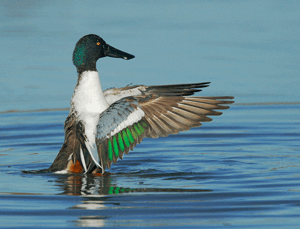
Caption: This Northern Shoveler is standing up to be counted! (Photo: Tom Grey ©)
[BIRDNOTE THEME]
GELLERMAN: Over much of North America, skeins of geese and ducks are heading south down the flyways to warmer climes. But as the weather cools, some birds flock to wetlands and waters not so far away. Frank Corrado has this BirdNote®.
[LOUD QUACKING OF DUCKS, SPLASHING SOUNDS]
CORRADO: Autumn brings back many kinds of ducks to our lakes and ponds, but few are as instantly recognizable as the duck aptly named Northern Shoveler. The Northern Shoveler’s oversized, spoon-shaped bill helps it stand out in even the most crowded pond.
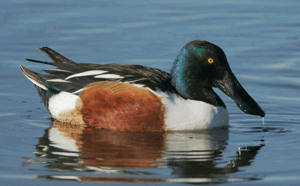
The Northern Shoveler uses its large bill to filter out food from the water’s surface. (Photo: Tom Grey ©)
[VOCALIZATIONS OF THE NORTHERN SHOVELER]
CORRADO: And while it doesn’t actually use its bill to shovel, the Northern Shoveler’s extra-large bill has a very special function. Many ducks tip downward to feed, their heads submerged, their tails pointing to the sky. The shoveler, though, skims tiny plants and animals off the water’s surface. Holding its bill flat at the surface and moving its head side to side, the shoveler pulls water in at the tip of its bill, then filters out the edibles with the help of tiny comb-like structures on its tongue.

This Northern Shoveler is standing up to be counted!(Photo: Tom Grey ©)
[VOCALIZATIONS OF THE NORTHERN SHOVELER]
CORRADO: And shovelers are social feeders. Picture dozens of shovelers feeding side-by-side as one: a feathered phalanx paddling and sweeping the surface, all the while rotating in a circular pattern across the pond. A pin-wheeling mass of feathers and bills, in shades of emerald-green, brown, and white.
[SOUNDS OF THE NORTHERN SHOVELER]
GELLERMAN: That’s Frank Corrado for BirdNote®. You can see videos of Northern Shovelers at our website, L-O-E dot org. And while you’re online, flap on over to our Facebook page. It’s PRI’s Living on Earth.
Related links:
- BirdNote® Northern Shovelers Pinwheeling was written by Bob Sundstrom
- Bird calls provided by The Macaulay Library of Natural Sounds at the Cornell Lab of Ornithology, Ithaca, New York. Mallards recorded by A. A. Allen. Northern Shoveler calls recorded by W.W.H. Gunn.
[MUSIC: Anat Fort “Minnesota” from And If (ECM Records 2010).]
Wearing Local
GELERMAN: In Northern California there’s a new fashion: think globally-----dress locally. Clothing makes the environmentalist for a woman who has sworn off materials from afar and will only dress in local-ware. Reporter Lonny Shavelson has our story.
[BIKE SOUNDS]
SHAVELSON: On a hot day in hilly suburban Fairfax California, Katherine Jolda is pumping her bicycle pedals. But the bike doesn’t move. That’s because the bike chain has been detached from the wheel, and attached to two large spinning metal drums coated with fine teeth rotating against each other. Jolda feeds raw wool, right off a sheep, into what she calls her carding contraption.
JOLDA: It’s carding the wool, and carding is basically brushing the wool out.
SHAVELSON: The drum’s teeth yank the wool in, chew on it, and then spit it out the other side.
JOLDA: And all the fibers are smooth and it’s untangled. And from there, I make felt from it.
[WOMEN’S VOICES]
SHAVELSON: Jolda is teaching an energized group of women to start with wool from local sheep, and finish with clothing for Rebecca Burgess, a 32-year old lover of textiles and the environment. She’s vowed that every item of clothing she wears in the next year will be made from local materials.
BURGESS: I thought I was quite the environmentally conscious person, but I had a closet packed with clothes. 15 pairs of pants, 30 shirts, 20 sweaters…..
SHAVELSON: Burgess learned from Patagonia’s Footprint Chronicles that the production and shipping of much of the clothing she owned put some 40 times its weight in carbon dioxide into the atmosphere, and that enormous textile factories are huge fresh water polluters. So she cut the size of her wardrobe.
BURGESS: Two skirts, two pairs of pants, one sweatshirt, one sweater, a swimsuit…
SHAVELSON: But for Burgess, that didn’t go far enough to protect the environment. She knew she loved cotton.
BURGESS: And so I thought if I could find a cotton farmer.
SHAVELSON: So she asked around, and…
BURGESS: She’s 90 miles from my front door, growing cotton.
SHAVELSON: She also loved wearing wool clothes from alpaca, a small version of a llama.
BURGESS: And I looked at where’s the alpaca being raised. Well, 147 miles from my front door.
SHAVELSON: And that was the birth of the Fibershed Project. Just like your watershed geographically defines your supply of water, a fibershed is the region that supplies your clothing fibers. Right now, it’s the entire world; not very local. Burgess has limited the source of materials for her clothes to a radius of 150 miles of her house-- a local fibershed. In support, dozens have joined to help make her clothes.
[SOUNDS OF GROUP: And then you’ll take the second half of the wool…]
SHAVELSON: In Burgesses’ backyard garden of plants grown for their dyes, Katherine Jolda, removes the wool from the bicycle carder and wets it with hot water to begin forming felt.
JOLDA: Felting really is the most efficient way that I’ve found of turning the raw material into a useful apparel.
SHAVELSON: Jolda hands the felted wool to Burgess.
[SOUNDS OF STIRRING POT]
SHAVELSON: She immerses it in a huge pot of boiling water richly colored with indigo dye from plants she’s grown…
BURGESS: And I’ve been raising it and honing it through seed selection, to grow well in my climate.
SHAVELSON: Okay, reality check. Burgess lives in the San Francisco Bay Area. So do about seven million other people. How many can have their clothing come from local sheep or cultivate indigo for color? Can this be scaled up to any practical environmental benefit?
ULASEWICZ: No, not domestically. It’s not a scaleable idea.
SHAVELSON: San Francisco State University Apparel professor Connie Ulasewicz co-authored the book ‘Sustainable Design.’ She says the fibershed project is dependent on Burgesse’s extraordinary knowledge and dedication in a geographic area rich in natural plant fibers, animals and activists.
ULASEWICZ: I think this is an ecological curiosity going on in Northern California.
SHAVELSON: But, says the professor, criticizing the Fibershed Project because it can’t be scaled up to millions of clothing buyers in a fabric-based environmental revolution misses the point. This project she says, reflects a general movement in the garment industry toward sustainability.
ULASEWICZ: Sustainable design, green design, eco-design. How can we simplify, reduce carbon footprints. There is a great movement to produce local, to manufacture local.
SHAVELSON: And in that sense, she says, the Fibershed Project should not be judged by whether it’s upwardly scaleable in money or marketing…
ULASEWICZ: But scaleable in the idea of the value and the meaning for this individual and what others can learn from that, it’s interesting, it’s more than interesting. What she is doing with her inspiration for this project is also the idea of I can sustain myself.
SHAVELSON: Burgess admits that a local wardrobe is for the rare few, like her, with time, skills, and a lot of supportive friends to design, dye, weave and sew. But she says the Fibershed Project also illustrates the grand ecological errors of the textile industry. Take the wool being fed into the backyard bicycle-carding mill.
[BICYCLE SOUNDS]
SHAVELSON: The region’s sheep are raised for meat, not wool. The ranchers had been throwing the wool into landfills, 70,000 pounds of it a year— until Burgess started gathering some for her clothes. The rest still goes to landfills. Says Burgess…
BURGESS: We’re importing millions of pounds of wool from New Zealand, it’s being milled in China, and yet we’re throwing wool away here.
SHAVELSON: And since this all started with Burgesse’s realization that her commercially-made clothes create a huge carbon imprint—she’s now calculating the environmental impact of her fibershed clothes. What’s her carbon output when she drives to sheep ranches to get wool? Or transport locally grown cotton just for her use? How much water does it take to wash the wool and cotton, irrigate her dye plants? How much energy to boil water to make the dyes, and run her sewing machine, light her workshop? Burgess estimates that fibershed clothes are less environmentally costly, but the data is not in yet. For Living on Earth, I’m Lonny Shavelson.
GELLERMAN: To see a slideshow of the Fibershed Project, go to our website L-O-E dot org.
Related links:
- Rebecca Burgess & the Fibershed Project
- The Fibershed Project blog
[MUSIC: dZhian & Kamien “Stiff Jazz” from Gran Riserva (Couch Records 2002).]
GELLERMAN: On the next Living on Earth, new studies suggest the first nine months could be the whole nine yards.
SKINNER: These early life events causing later life disease is something we need to think about more in terms of medicine. What you are, is to a large degree, determined what your mother did during pregnancy.
GELLERMAN: New findings from the science of epigenetics, next time on Living on Earth.
[BARKING OF CALIFORNIA SEA LIONS]
GELLERMAN: The belching, sneezing, choking and wheezing may sound like a bad cold, but the barking gives it away.
|
|
[BARKING OF CALIFORNIA SEA LIONS]
GELLERMAN: These noisy mammals are California Sea Lions. Producer Mark Seth Lender made this recording at a floating pier outside Elkhorn Slough in Monterey Bay. It’s an area the sea lions called their own for thousands of years before people drove them away. But the sea lions have learned a pier is as good a place as any to haul out, and thanks to the Marine Mammal Protection Act, the pinnipeds are back.
[BARKING SOUNDS OF CALIFORNIA SEA LIONS]
GELLERMAN: Living on Earth is produced by the World Media Foundation. Our crew includes Bobby Bascomb, Eileen Bolinsky, Ingrid Lobet, Helen Palmer, Jessica Ilyse Smith, Ike Sriskandarajah, Mitra Taj, and Jeff Young with help from Sarah Calkins, and Sammy Sousa. Our interns are Nora Doyle-Burr and Honah Liles. We had engineering help this week from Dana Chisholm. Jeff Turton is our technical director. Alison Lirish Dean composed our themes. Steve Curwood is our Executive Producer.
You can find us anytime at loe dot org. And while you’re on line, visit myplanetharmony.com. Our sister program, Planet Harmony, welcomes all and pays special attention to stories affecting communities of color. Log on and join the discussion at MyPlanetHarmony dot com. I’m Bruce Gellerman, thanks for listening.
ANNOUNCER: Funding for Living On Earth comes from the National Science Foundation supporting coverage of emerging science. And Stonyfield farm, organic yogurt and smoothies. Stonyfield pays its farmers not to use artificial growth hormones on their cows. Details at Stonyfield dot com. Support also comes from you, our listeners. The Ford Foundation, The Town Creek Foundation, The Oak Foundation—supporting coverage of climate change and marine issues. And Pax World Mutual Funds, integrating environmental, social, and governance factors into investment analysis and decision making. On the web at Pax world dot com. Pax World for tomorrow.
ANNOUNCER 2: PRI – Public Radio International
Living on Earth wants to hear from you!
Living on Earth
62 Calef Highway, Suite 212
Lee, NH 03861
Telephone: 617-287-4121
E-mail: comments@loe.org
Newsletter [Click here]
Donate to Living on Earth!
Living on Earth is an independent media program and relies entirely on contributions from listeners and institutions supporting public service. Please donate now to preserve an independent environmental voice.
NewsletterLiving on Earth offers a weekly delivery of the show's rundown to your mailbox. Sign up for our newsletter today!
 Sailors For The Sea: Be the change you want to sea.
Sailors For The Sea: Be the change you want to sea.
 The Grantham Foundation for the Protection of the Environment: Committed to protecting and improving the health of the global environment.
The Grantham Foundation for the Protection of the Environment: Committed to protecting and improving the health of the global environment.
 Contribute to Living on Earth and receive, as our gift to you, an archival print of one of Mark Seth Lender's extraordinary wildlife photographs. Follow the link to see Mark's current collection of photographs.
Contribute to Living on Earth and receive, as our gift to you, an archival print of one of Mark Seth Lender's extraordinary wildlife photographs. Follow the link to see Mark's current collection of photographs.
 Buy a signed copy of Mark Seth Lender's book Smeagull the Seagull & support Living on Earth
Buy a signed copy of Mark Seth Lender's book Smeagull the Seagull & support Living on Earth


